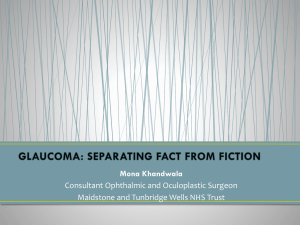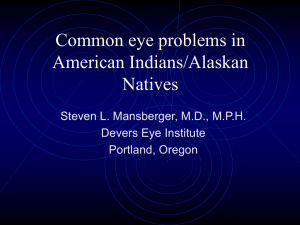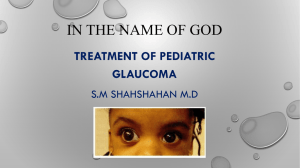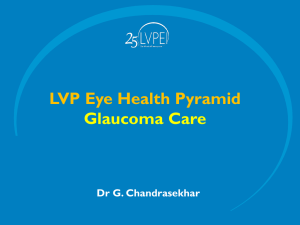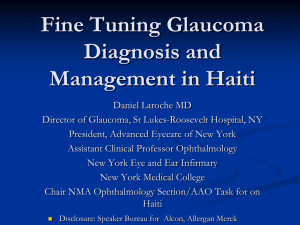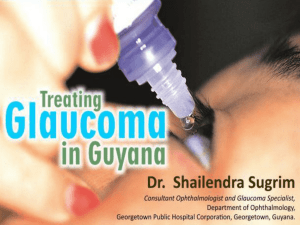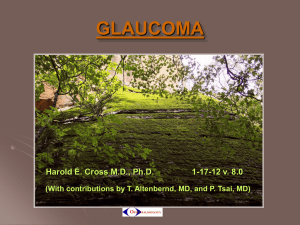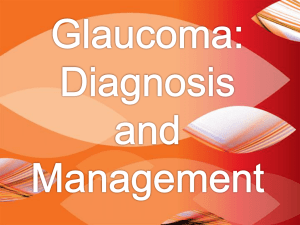Prof Nathan Congdon_Overview of the Global Glaucoma Problem
advertisement
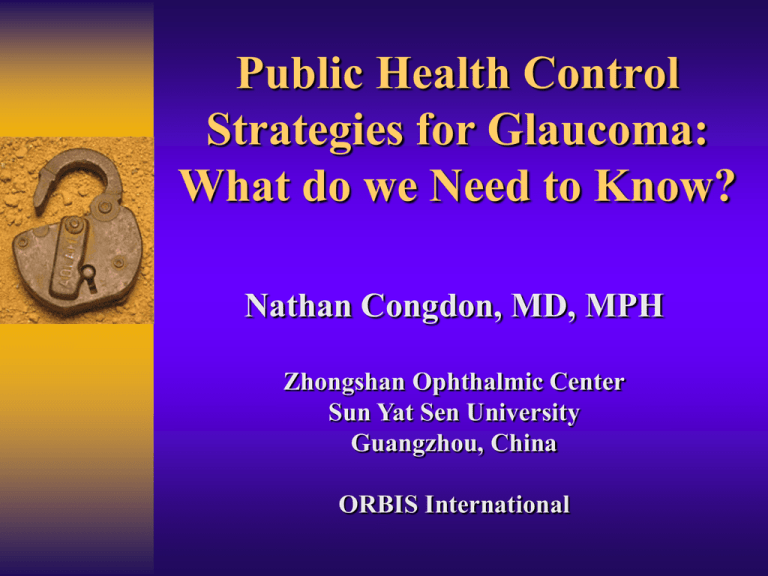
Public Health Control Strategies for Glaucoma: What do we Need to Know? Nathan Congdon, MD, MPH Zhongshan Ophthalmic Center Sun Yat Sen University Guangzhou, China ORBIS International Financial interest No financial interest An explosion of new knowledge about glaucoma and other eye disease Visual burden of glaucoma increasing despite new knowledge Number Blind and Vision Impaired in the U.S. Population Aged 40 and over 6,000,000 5,000,000 4,000,000 2000 3,000,000 2010 2020 2,000,000 1,000,000 0 Blind Low Vision All Vision Impaired This talk Questions to ask: – What model for glaucoma programs in areas of limited resources? – What do we need to know to implement these programs well? Introduce ideas this session will focus on: – ZAP and EAGLE studies, CREST program, Aravind tube shunt Emphasis on Asia: – Evidence of significant disease burden – Availability of resources A strategy for glaucoma in rural Asia: Start in the clinics Clinic-based case-finding: – Economic models1 suggest that population-based approach is not cost effective – Uncertainty about morbidity associated with largescale programs of PI for narrow angles Target is persons aged 40+ years presenting for eye care, and who are at risk for BLINDNESS from glaucoma 1 Burr JM, et al. The clinical effectiveness and cost-effectiveness of screening for open angle glaucoma: a systematic review and economic evaluation. Health Technol Assess 2007;11(41):iii-iv,ix-x,1-190. A strategy for glaucoma in rural Asia: Screening for narrow angles Gonioscopy, possibly with van Herrick testing as a “pre-screen” The GOOD – Cheap (US$75 goniolenses available in India) – Still the gold standard, no proof yet that other modalities are better The BAD – Highly dependent on quality of training – Cutoffs for intervention are not well-defined A strategy for glaucoma in rural Asia: Screening for glaucoma Principal focus on evaluation of the disc – Emphasis on detecting patients with severe damage – Very limited evidence for utility of field testing in persons without fieldtaking experience – Post-operative evaluation of the nerve in patients with dense cataract A strategy for glaucoma in rural Asia: Treatment Strategy may differ between urban and rural settings: – Glaucoma drops widely available in urban China and India for US$1 per bottle – Barriers of opportunity cost, transportation and availability make long-term medical therapy untenable in most rural areas – In these areas, surgical therapy will likely predominate A strategy for glaucoma in Asia: Integrate glaucoma into the eyecare system In areas of limited resources, a “glaucoma program” is not going to make sense Similar equipment and training should also build capacity to care for DR (for example) The patient may have come 100 km, we have to be willing to move 5 mm from the optic nerve to the fovea! The knowledge gap What do we need to know in order to scale up glaucoma treatment in Asia? Treatment of narrow angles, ACG Any expansion of service provision for persons with narrow angles requires a better understanding of the risk-benefit ratio for available treatments. – What are the long-term effectiveness of cataract extraction versus PI for NA/AC? (EAGLE, ZAP) – What are incidence/progression rates of cataract, corneal decompensation, visually significant glare, RD after PI? (ZAP) The CREST Network: Comprehensive Rural Eyecare Service and Training A collaboration between ORBIS International, Zhongshan Ophthalmic Center and ten rural, countylevel hospitals in Guangdong Province Aim: To build capacity of rural hospitals to provide comprehensive eye care (including both glaucoma and DR) Platform for programmatic research on management of glaucoma and DR in rural Asia Current knowledge and attitudes about glaucoma in rural China Focus Group studies of doctors and patients in rural Guangdong have revealed widespread mis-conceptions (Arch Ophhalmol 2012;130:761-70 ): – Glaucoma viewed as rare – Highly-symptomatic disease Thorough examinations of angle and optic nerve only done on rare patients with obvious symptoms Research on physician training Change in practice patterns: – Goal is routine full exam for ALL patients > 40 years – Use of electronic medical record network tying 10 rural hospitals to ZOC to assess documentation of key facets of glaucoma exam: • IOP • Gonioscopy • Optic nerve – Before and after training Research on physician training A study of rural physicians’ ability to detect glaucoma damage in the optic nerve is also under way Testing before and after training using the GONE Website: – Jonathan Crowsdon, CERA, Australia – Chinese-language version of website now exists Research on patient education RCT of intervention to increase uptake of glaucoma examinations in clinic: – Videos made especially for the project Key ideas: – Glaucoma asymptomatic – Need comprehensive exam to detect un-suspected disease – Potential for severe, irreversible vision loss if wait for symptoms Research on patient education Patients are unsatisfied with vision after glaucoma surgery: “negative social marketing” – RCT of educational intervention including videos – Explain purpose of glaucoma surgery – Prepare patients for likelihood of blurred VA – Outcome is post-op satisfaction level, willingness to recommend surgery Research on patient compliance Patient long-term compliance with recommended DR care and post op glaucoma visits is poor (Ophthalmology 2010;117:1755-62.) – Funding from WDF to create automated cellphone SMS reminder system – Increases 6-month compliance from 36% to 86% in peds cataract (Ophthalmology in press) – 95% of local rural patients have access to cell service Future issues: Research on glaucoma treatment Outcomes of conventional surgeries (trab, surgical PI) in this setting Could inexpensive, locally-made tube shunts, ExPress valves etc. be better-suited to rural surgeons and lower patient compliance? What is impact of this limited, clinic-based strategy on preventing glaucoma blindness in the population? Conclusion Many knowledge gaps still exist in our understanding of managing glaucoma in areas of limited resources Research can help to fill these gaps, and in doing so to improve the effectiveness and efficiency of programs

